Actors, Scales and Spaces Dynamics Linked to Groundwater Resources use for Agriculture Production in Haouaria Plain, Tunisia. A Territory Game Approach
Abstract
:1. Introduction
2. Materials and Methods
2.1. The Territory Game Concept and Design
2.2. The Haouaria Plain in the Cap Bon, Tunisia
2.3. Data Collection, Preparation and Implementation of the Territory Game
2.4. Analysis of the Territory Game Results
3. Results and Discussion
3.1. Results of the Territory Game Workshop
3.1.1. Choice of the Thematic Cards
3.1.2. Diagnosis of Actual Situation and Actors’ Perception of Territorial Dynamics
3.1.3. Future Scenarios
3.1.4. Drivers for Change: Levers and Obstacles for Scenarios Implementation and Actions Pathways
3.2. Analyzing the Territory Game Outputs
3.2.1. Main Dynamics
3.2.2. Summary of Key Issues and Proposed Actions
3.3. Reflection on the Limitation and the Efficacity of the Territory Game Workshop
4. Conclusions
Author Contributions
Funding
Acknowledgments
Conflicts of Interest
References
- Therond, O.; Debril, T.; Duru, M.; Magrini, M.-B.; Plumecocq, G.; et Sarthou, J.P. Socio-Economic Characterization of Agriculture Models. Agroecological Transitions: From Theory to Practice in Local Participatory Design; Springer Nature: Basel, Switzerland, 2019; p. 335. [Google Scholar]
- Scanlon, B.R.; Faunt, C.C.; Longuevergne, L.; Reedy, R.C.; Alley, W.M.; McGuire, V.L.; McMahon, P.B. Groundwater depletion and sustainability of irrigation in the US High Plains and Central Valley. Proc. Natl. Acad. Sci. USA 2012, 109, 9320–9325. [Google Scholar] [CrossRef] [Green Version]
- Wada, Y.; Van Beek, L.P.H.; Bierkens, M.F. Nonsustainable groundwater sustaining irrigation: A global assessment. Water Resour. Res. 2012, 48. [Google Scholar] [CrossRef]
- Dalin, C.; Taniguchi, M.; Green, T.R. Unsustainable groundwater use for global food production and related international trade. Glob. Sustain. 2019, e2. [Google Scholar] [CrossRef] [Green Version]
- Llamas, M.R.; Martínez-Santos, P. Intensive groundwater use: Silent revolution and potential source of social conflicts. J. Water Resour. Plan. Manag. 2005, 131, 337–341. [Google Scholar] [CrossRef]
- Garrido, A.; Martínez-Santos, P.; Llamas, M.R. Groundwater irrigation and its implications for water policy in semiarid countries: The Spanish experience. Hydrogeol. J. 2006, 14, 340. [Google Scholar] [CrossRef]
- Foster, S.; Garduño, H. Groundwater-resource governance: Are governments and stakeholders responding to the challenge? Hydrogeol. J. 2013, 21, 317–320. [Google Scholar] [CrossRef]
- Gomes, S.; Hermans, L.; Islam, K.; Huda, S.; Hossain, A.T.M.; Thissen, W. Capacity building for water management in peri-urban communities, Bangladesh: A simulation-gaming approach. Water 2018, 10, 1704. [Google Scholar] [CrossRef] [Green Version]
- Lardon, S. TATA-BOX: A Model for Participatory Processes? In Agroecological Transitions: From Theory to Practice in Local Participatory Design; Springer: Berlin/Heidelberg, Germany, 2019; pp. 289–304. [Google Scholar]
- Rodela, R.; Ligtenberg, A.; Bosma, R. Conceptualizing serious games as a learning-based intervention in the context of natural resources and environmental governance. Water 2019, 11, 245. [Google Scholar] [CrossRef] [Green Version]
- Meinzen-Dick, R.; Janssen, M.A.; Kandikuppa, S.; Chaturvedi, R.; Rao, K.; Theis, S. Playing Games to Save Water: Collective Action Games for Groundwater Management in Andhra Pradesh, India. World Dev. 2018, 107, 40–53. [Google Scholar] [CrossRef]
- Daniell, K.A.; White, I.; Ferrand, N.; Ribarova, I.S.; Coad, P.; Rougier, J.; Hare, M.; Jones, N.A.; Popova, A.; Rollin, D.; et al. Co-engineering participatory water management processes: Theory and insights from Australian and Bulgarian interventions. Ecol. Soc. 2010, 15, 11. [Google Scholar] [CrossRef] [Green Version]
- Soulard, C.; Lardon, S. Action-Research Helps Researchers Foster Smart Rural Development: Two Case Studies on Local Food Policy. Syst. Pr. Action Res. 2019, 32, 155–166. [Google Scholar] [CrossRef]
- Caraveli, H. A comparative analysis on intensification and extensification in Mediterranean 473 agriculture: Dilemmas for LFAs policy. J. Rural Stud. 2000, 16, 231–242. [Google Scholar] [CrossRef]
- Debolini, M.; Marraccini, E.; Dubeuf, J.P.; Geijzendorffer, I.R.; Guerra, C.; Simon, M.; Targetti, S.; Napoléone, C. Land and farming system dynamics and their drivers in the Mediterranean Basin. Land Use Policy 2018, 75, 702–710. [Google Scholar] [CrossRef]
- Angeon, V.; Lardon, S. Participation and governance in territorial development projects. The «territory game» as a local leadership system. Int. J. Sustain. Dev. 2008, 11, 262–281. [Google Scholar] [CrossRef]
- Lardon, S.; Marracini, E.; Filippini, R.; Gennai-Schott, S.; Johany, F.; Rizzo, D. Prospective participative pour la zone urbaine de Pise (Italie). L’eau et l’alimentation comme enjeux de développement territorial. Cah. Geog. Québec 2016, 170, 265–286. [Google Scholar]
- Lardon, S. Developing a territorial project. The ‘territory game’, a coordination tool for local stakeholders. FaçSADe 2013, 38, 1–4. [Google Scholar]
- Newell, E.B.; Marsh, D.M.; Sharma, D. Enhancing the resilience of the Australian national electricity market: Taking a systems approach in policy development. Ecol. Soc. 2011, 2, 15. [Google Scholar] [CrossRef] [Green Version]
- INS. Annuaire des Statistiques 1998–2010; Institut National des Statistiques: Tunis, Tunisia, 2010. [Google Scholar]
- SCET. Actualisation des Connaissances Hydrogéologiques et des Données Socioéconomiques for Haouaria Plain Tunisia; Tunisian Ministry of Agriculture: Tunis, Tunisia, 2006.
- CRDA-Nabeul. Annual Report of 2011 Activities; Technical Report; Regional planning Commission for Agricultural Development: Nabeul, Tunisia, 2011. (In French) [Google Scholar]
- CTV Haouaria. Data on Agriculture Monitoring in Haouaria Region 2015; Technical Report; Territorial Extension Unit: Haouaria, Tunisia, 2015. (In Arabic) [Google Scholar]
- Elloumi, M. La Gouvernance des Eaux Souterraines en Tunisie, Report No. 6; IWMI Project Publication ‘Groundwater Governance in the Arab World’; IWMI: Cairo, Egypt, 2016. [Google Scholar]
- Mekki, I.; Ghazouani, W.; Closas, A.; Molle, F. Perceptions of groundwater degradation and mitigation responses in the Haouaria region in Tunisia. Groundw. Sustain. Dev. 2017, 5, 101–110. [Google Scholar] [CrossRef]
- Ghazouani, W.; Mekki, I. Les Ressources en Eaux Souterraines de la Plaine de Haouaria, Tunisie: État Fragile, Acteurs Multiples et Nécessité d’un Changement Intégré, Report No.7; IWMI Project Publication ‘Groundwater Governance in the Arab World’; IWMI: Cairo, Egypt, 2016. [Google Scholar]
- Closas, A.; Molle, F.; Hernández-Mora, N. Sticks and carrots to manage groundwater over-abstraction in La Mancha, Spain. Agric. Water Manag. 2017, 194, 113–124. [Google Scholar] [CrossRef]
- Ballard, D. Using learning processes to promote change for sustainable development. Action Res. 2005, 3, 135–156. [Google Scholar] [CrossRef]
- Pahl-Wostl, C. Aconceptual framework for analysing adaptive capacity learning processes in resource governance regimes. Glob. Environ. Chang. 2009, 19, 354–365. [Google Scholar] [CrossRef]
- de Castro-Pardo, M.; Pérez-Rodríguez, F.; Martín-Martín, J.M.; Azevedo, J.C. Planning for Democracy in Protected Rural Areas: Application of a Voting Method in a Spanish-Portuguese Reserve. Land Rev. 2019, 8, 145. [Google Scholar] [CrossRef] [Green Version]
- Arts, B.; Buizer, M.; Horlings, L.; Ingram, V.; Oosten, C.V.; Opdam, P. Landscape Approaches: A State-of-the-Art Review. Annu. Rev. Environ. Resour. 2017, 42, 439–463. [Google Scholar] [CrossRef]
- Bosomworth, K.; Gaillard, E. Engaging with uncertainty and ambiguity through participatory ‘Adaptive Pathways’ approaches: Scoping the literature. Environ. Res. Lett. 2019, 14, 093007. [Google Scholar] [CrossRef]
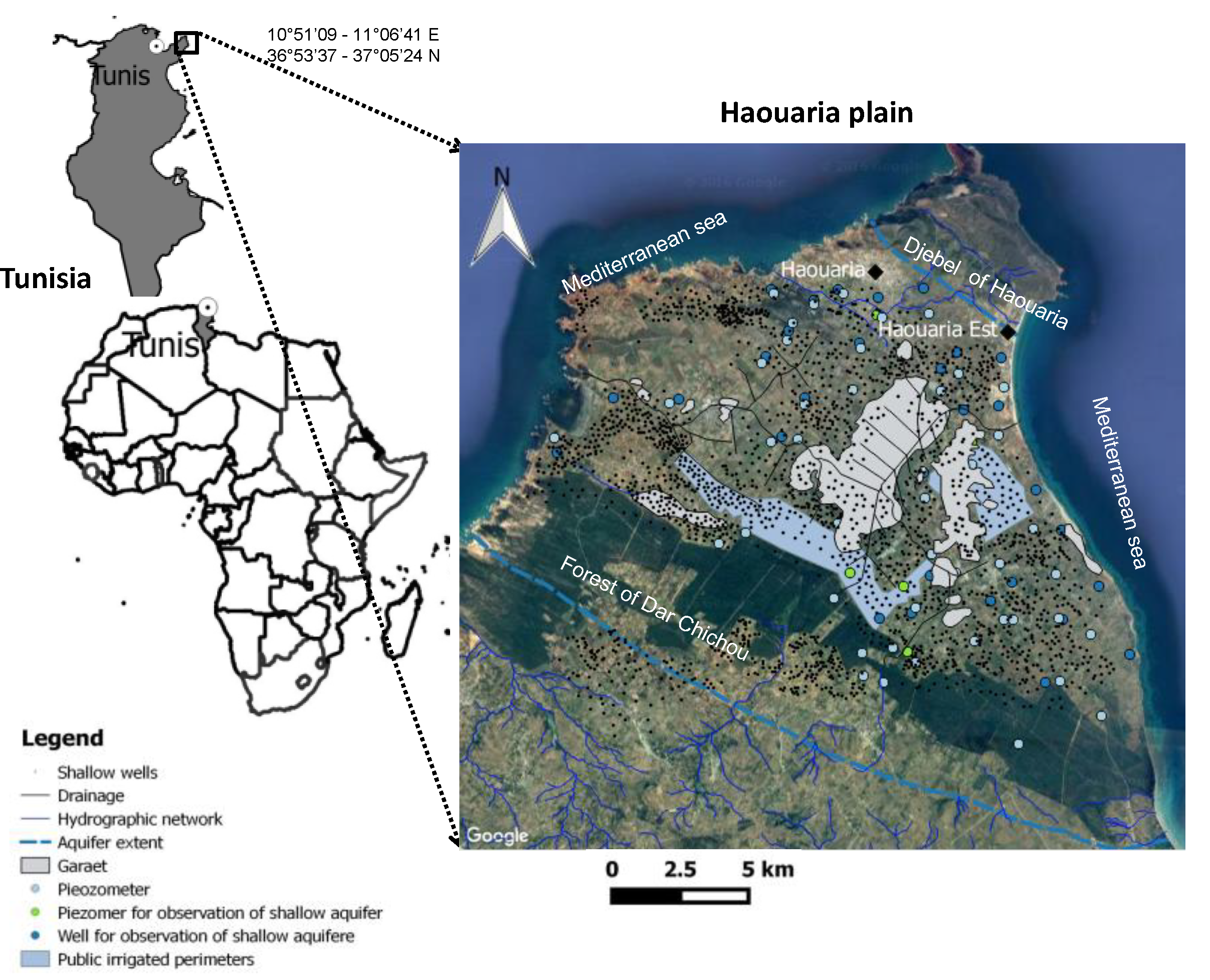
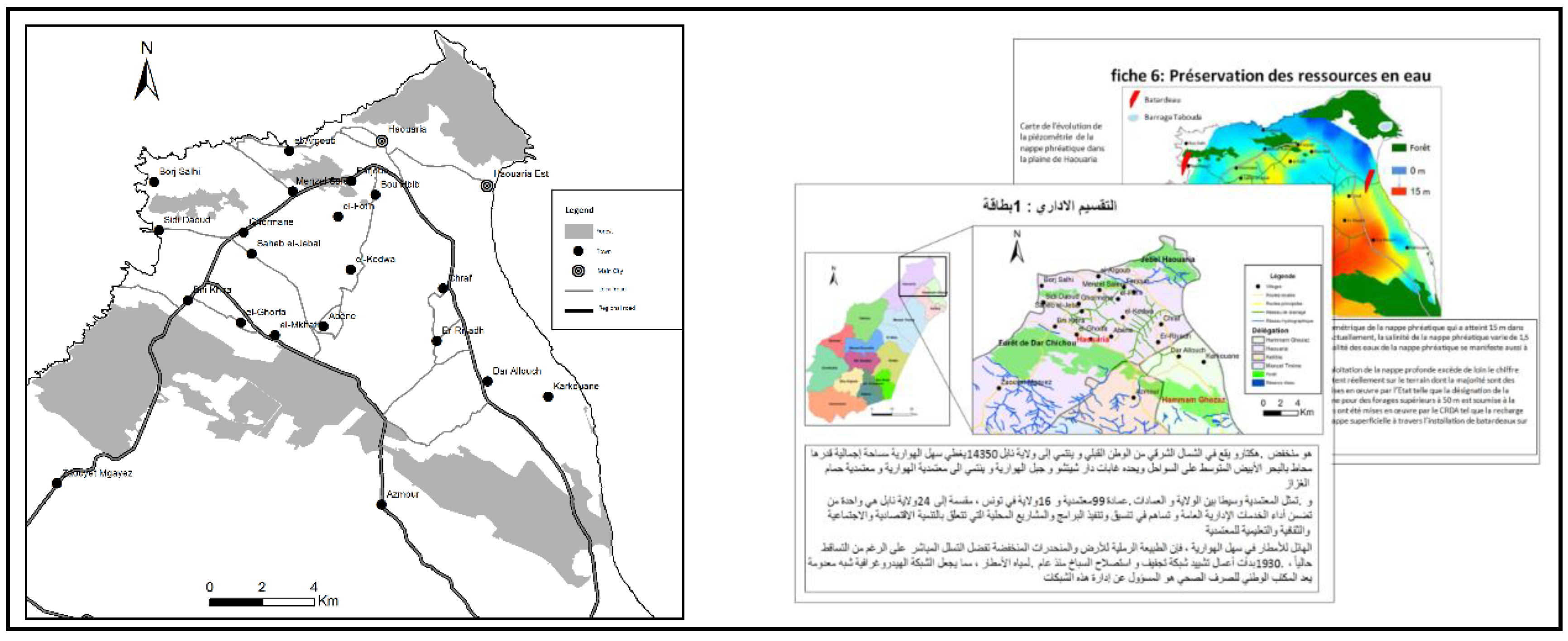

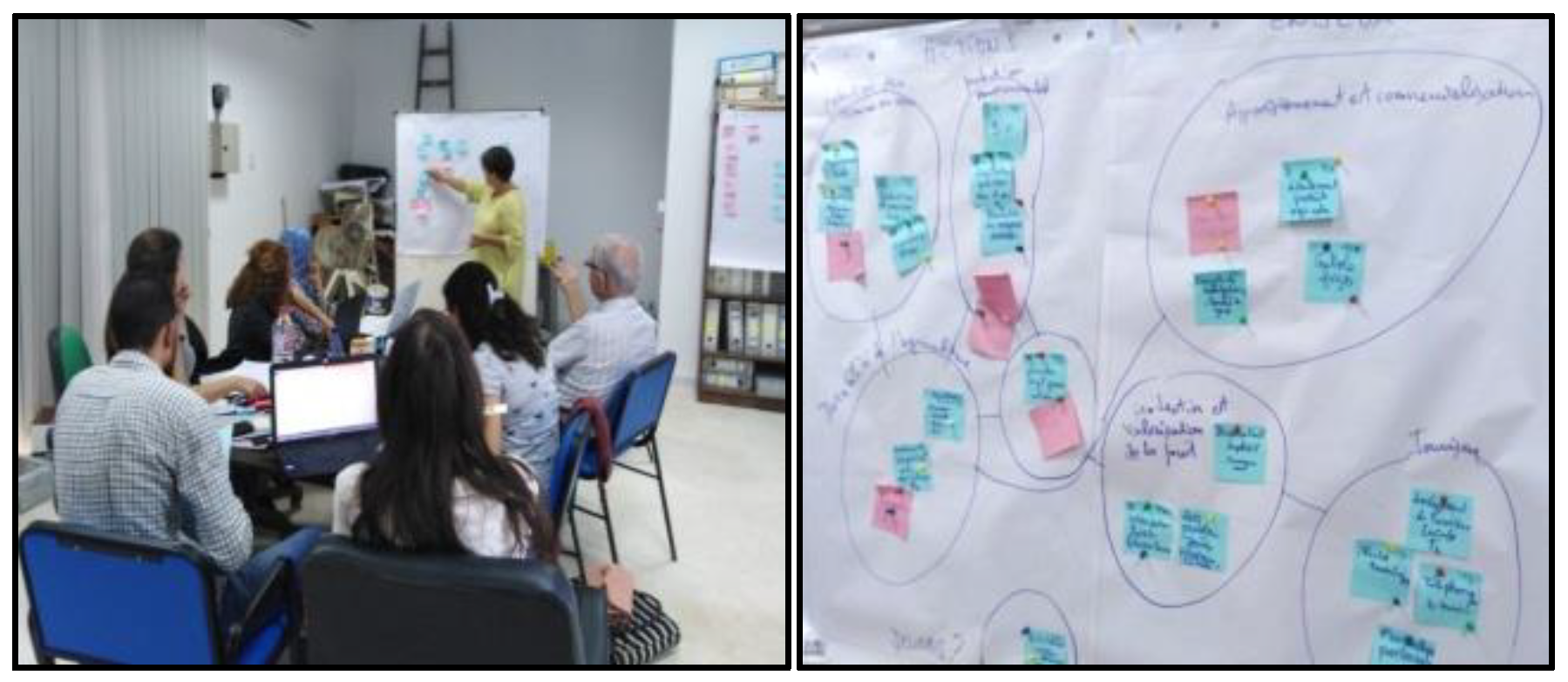
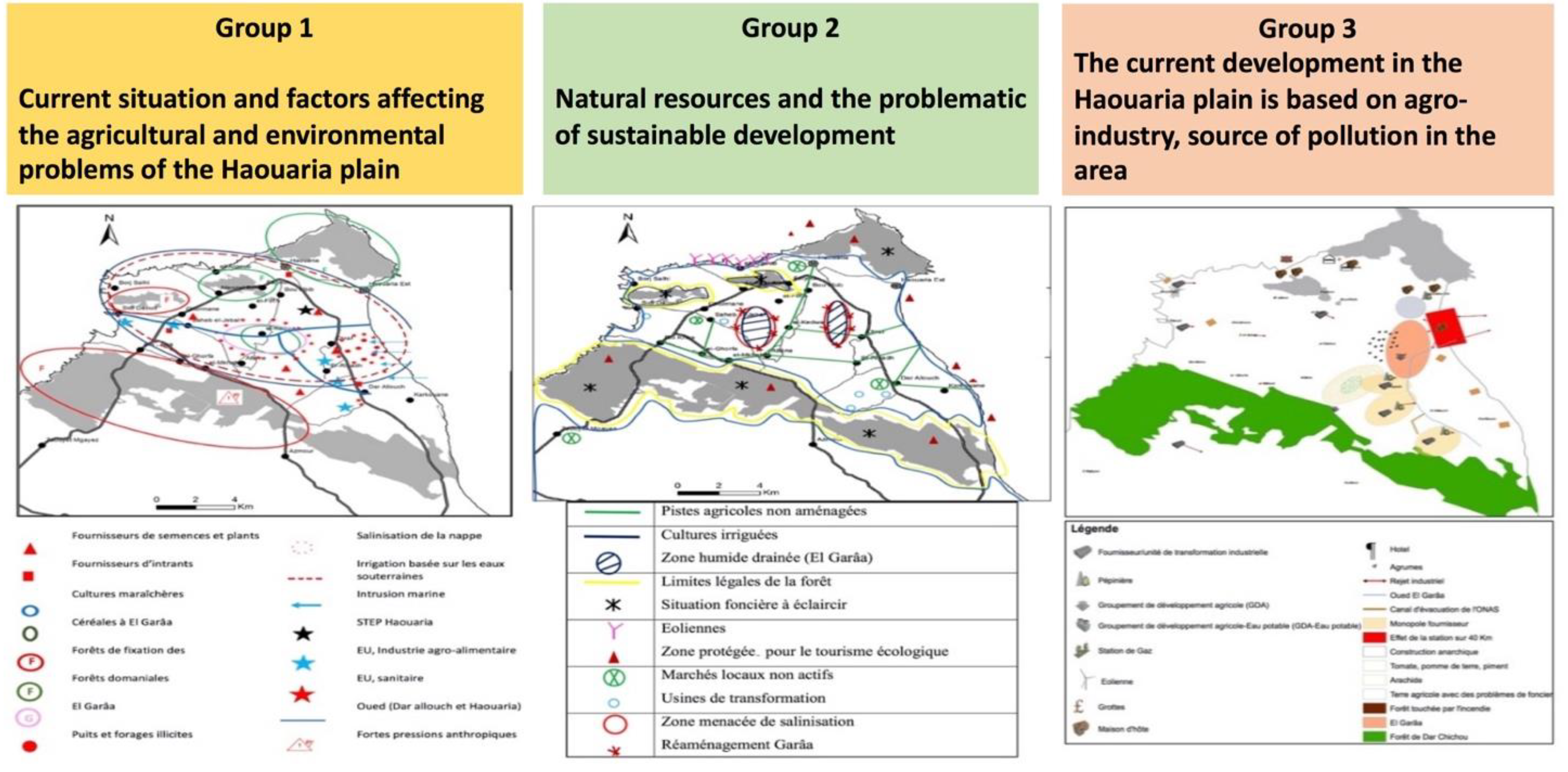
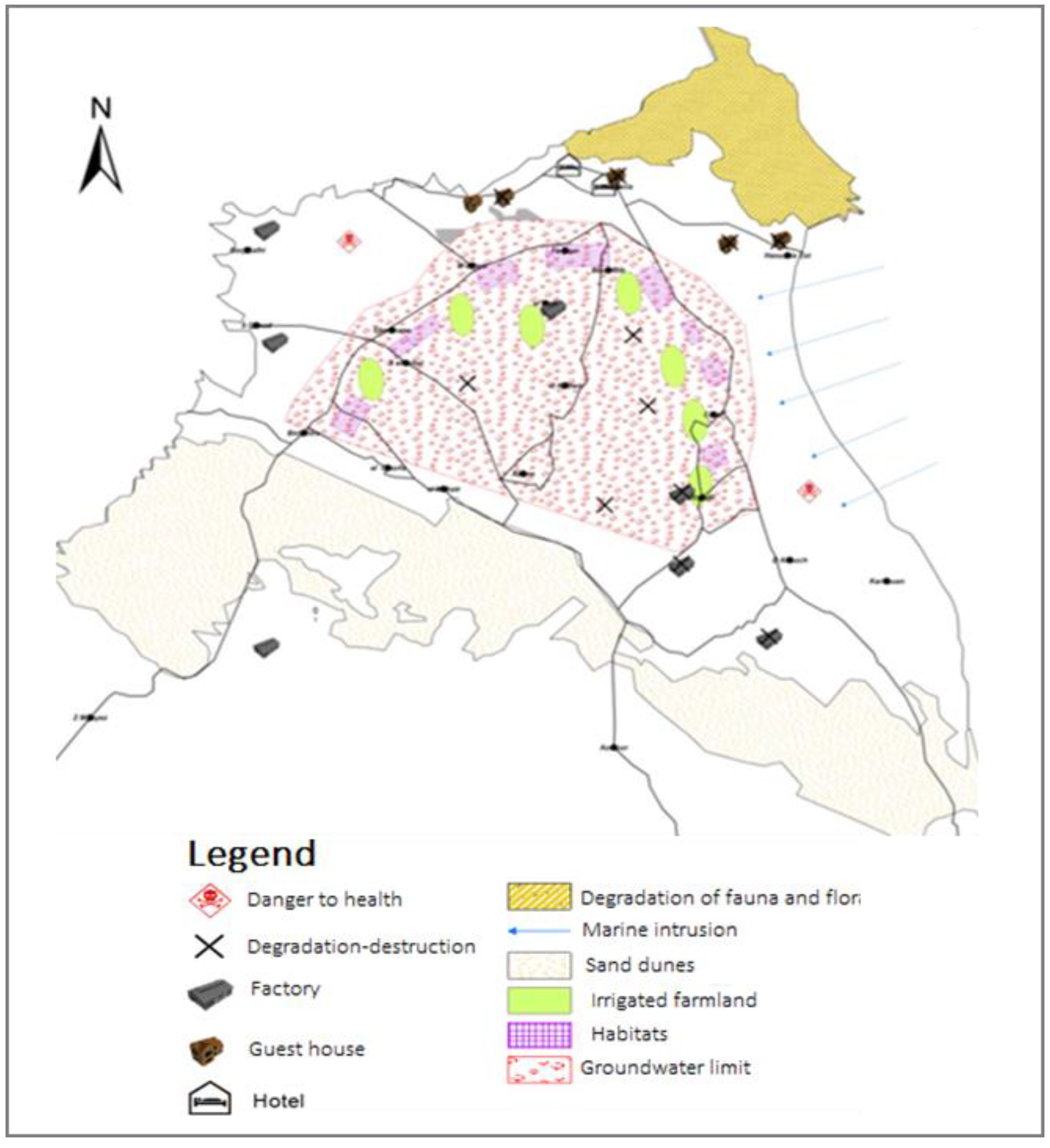
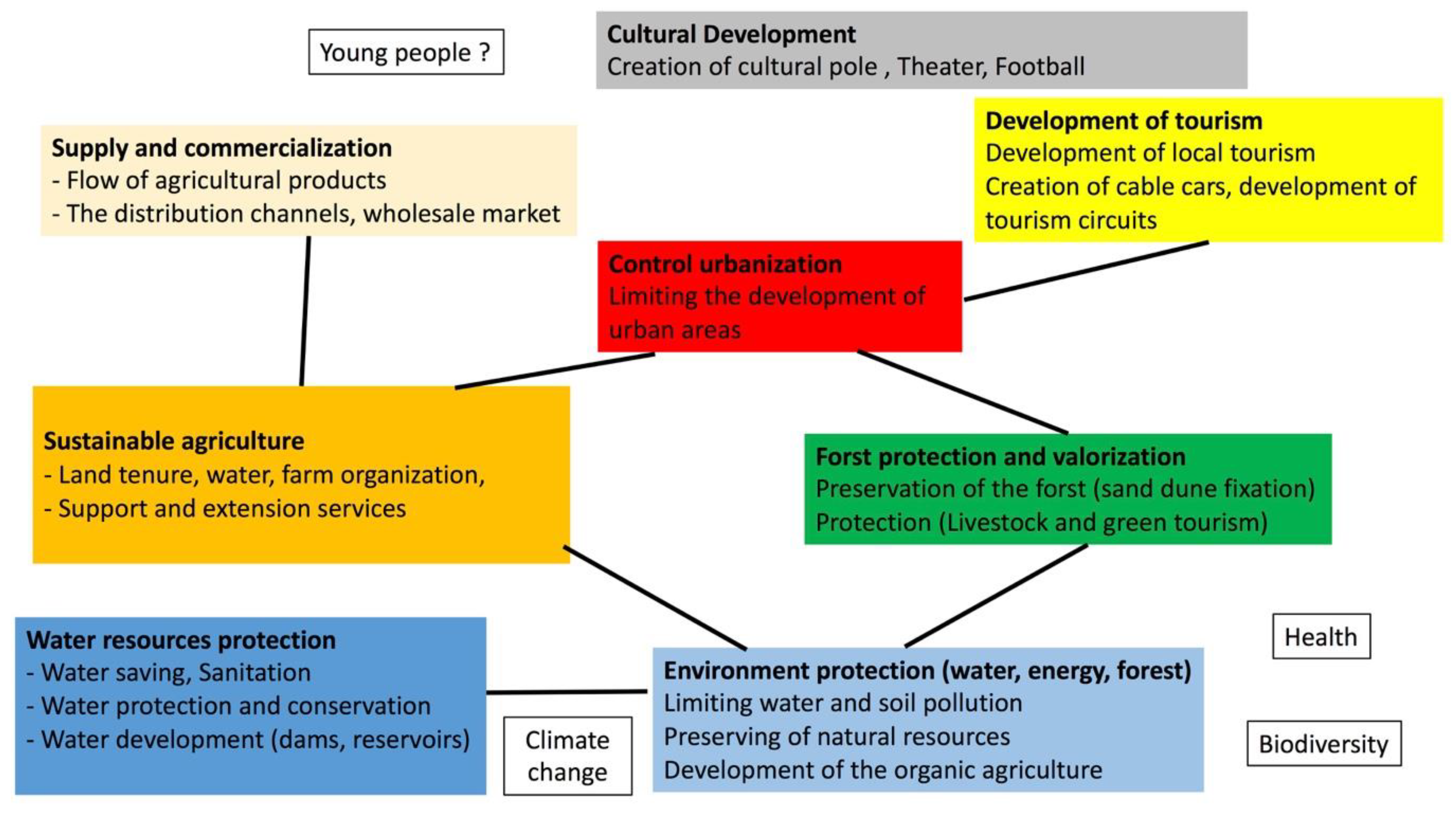
| N° of Package | N° of the Card, Thematic of the Card | ||
|---|---|---|---|
| 1 | 3, Road infrastructure | 10, Suppliers | |
| 2 | 4, Agriculture | 9, Conditioning units | |
| 3 | 2, Urbanization | 7, Forest and land | 14, Supervision and advise |
| 4 | 1, Administrative limits | 12, Local initiatives | 16, Energy, landscape and environment |
| 5 | 5, Exploitation and water resources management | 11, Distribution channels | 15, Employment and sector of activities |
| 6 | 6, Water resources preservation | 8, Products, processing | 13, Tourism |
| N° of Card | Thematic of Card | N° of Choices in the Three Tables |
|---|---|---|
| 4 | Agriculture | 3 |
| 7 | Forest and land | 3 |
| 5 | Exploitation and water resources management | 2 |
| 6 | Water resources preservation | 2 |
| 10 | Suppliers | 2 |
| 1 | Administrative limits | 1 |
| 3 | Road infrastructure | 1 |
| 8 | Agro-industries: products, processing | 1 |
| 11 | distribution channels | 1 |
| 13 | Tourism | 1 |
| 16 | Energy, landscape and environment | 1 |
| 2 | Urbanization | 0 |
| 9 | Conditioning units | 0 |
| 12 | Local initiatives | 0 |
| 14 | Supervision and advise | 0 |
| 15 | Employment and sector of activities | 0 |
| Thematic | Dynamic | Factors of Change |
|---|---|---|
| Forest | -Complexity of forest land status -Degradation of the forest | -Deforestation -Urban extension -Fires |
| Water resources | -Overexploitation of groundwater -The degradation of water quality | -Development of illicit wells -Problems of pollution of water |
| Supply and commercialization | -Difficulties in commercialization of agricultural products | -Monopolization of supply and commercialization |
| Tourism | -Absence of tourism infrastructure | -Low support for ecological tourism |
© 2020 by the authors. Licensee MDPI, Basel, Switzerland. This article is an open access article distributed under the terms and conditions of the Creative Commons Attribution (CC BY) license (http://creativecommons.org/licenses/by/4.0/).
Share and Cite
Ferchichi, I.; Mekki, I.; Elloumi, M.; Arfa, L.; Lardon, S. Actors, Scales and Spaces Dynamics Linked to Groundwater Resources use for Agriculture Production in Haouaria Plain, Tunisia. A Territory Game Approach. Land 2020, 9, 74. https://doi.org/10.3390/land9030074
Ferchichi I, Mekki I, Elloumi M, Arfa L, Lardon S. Actors, Scales and Spaces Dynamics Linked to Groundwater Resources use for Agriculture Production in Haouaria Plain, Tunisia. A Territory Game Approach. Land. 2020; 9(3):74. https://doi.org/10.3390/land9030074
Chicago/Turabian StyleFerchichi, Intissar, Insaf Mekki, Mohamed Elloumi, Lamia Arfa, and Sylvie Lardon. 2020. "Actors, Scales and Spaces Dynamics Linked to Groundwater Resources use for Agriculture Production in Haouaria Plain, Tunisia. A Territory Game Approach" Land 9, no. 3: 74. https://doi.org/10.3390/land9030074
APA StyleFerchichi, I., Mekki, I., Elloumi, M., Arfa, L., & Lardon, S. (2020). Actors, Scales and Spaces Dynamics Linked to Groundwater Resources use for Agriculture Production in Haouaria Plain, Tunisia. A Territory Game Approach. Land, 9(3), 74. https://doi.org/10.3390/land9030074




